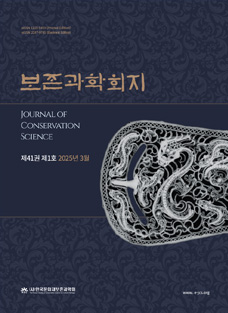Journal of Conservation Science Vol.27 No.1 pp.75-90
A Study of the Chemical Composition of Korean Traditional Ceramics (III) : Comparison of Punch’ŏng with Koryŏ Ware and Chosŏn Whiteware
한국 전통 도자기의 화학 조성에 대한 연구 (III) : 분청에 대한 고려자기와 조선백자와의 비교
Carolyn Kyongshin Koh,Woong Kil Choo,Sangdoo Ahn,Young Eun Lee,Gyu Ho Kim,Yeon Sook Lee
Abstract
At the beginning of the Chosŏn dynasty, punch’ŏng began as a simplified form of inlaid celadon, and in the two following centuries it developed into a popular folk craft in various styles and expressive decorations; overtime, it was increasingly made to resemble whiteware, and its production stopped after the Japanese invasion of Korea. In the present study, the body and glaze compositions of punch’ŏng were examined and compared with those of celadon and whiteware, whose compositions have previously been compared with those of Chinese ceramics. Here, the analyzed shards were organized into 28 groups based on their production sites and archaeological characteristics. For each group, the body and glaze compositions of several shards(usually three to five) were obtained, averaged, and compared with those of the other groups. These comparisons showed that the majority of the punch’ŏng bodies were formed, like those of celadon and whiteware, with mica-quartz porcelain stone, which was commonly used in Yuezhou, Jingdezhen, and other southern Chinese kilns. The glazes consisted of clay materials and flux components made from various proportions of wood ash, burnt limestone (glaze ash) and crushed limestone. Overall, the punch’ŏng glazes resembled the Koryŏ celadon and Koryŏ whiteware glazes more closely than the Chosŏn white wareglazes. However, the TiO2 levels found in the tested punch’ŏng were low, similar to those of Chosŏn whiteware; this indicated that glaze stone was used as the clay component of the punch’ŏng glazes, as was the case for Chosŏn whiteware. This study of the material characteristics of punch’ŏng may be used as a comparative framework for analyzing ceramic shards discovered at current and future excavations within Korea.

 E-Submission
E-Submission 
 E-Submission
E-Submission 
![]() Journal Search Engine
Journal Search Engine




 KSC
KSC